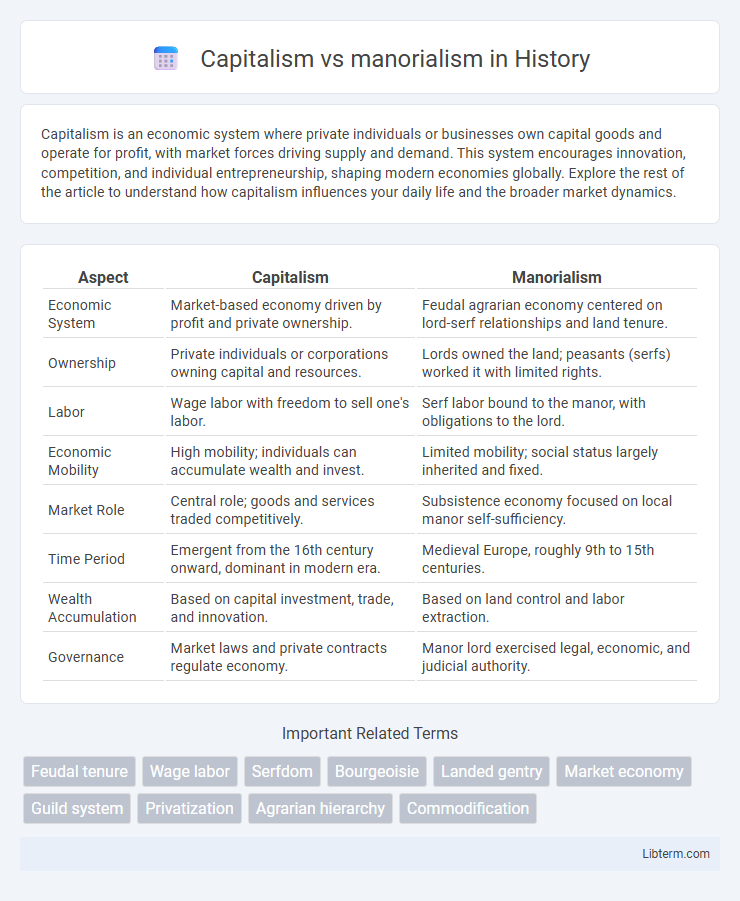Capitalism is an economic system where private individuals or businesses own capital goods and operate for profit, with market forces driving supply and demand. This system encourages innovation, competition, and individual entrepreneurship, shaping modern economies globally. Explore the rest of the article to understand how capitalism influences your daily life and the broader market dynamics.
Table of Comparison
| Aspect | Capitalism | Manorialism |
|---|---|---|
| Economic System | Market-based economy driven by profit and private ownership. | Feudal agrarian economy centered on lord-serf relationships and land tenure. |
| Ownership | Private individuals or corporations owning capital and resources. | Lords owned the land; peasants (serfs) worked it with limited rights. |
| Labor | Wage labor with freedom to sell one's labor. | Serf labor bound to the manor, with obligations to the lord. |
| Economic Mobility | High mobility; individuals can accumulate wealth and invest. | Limited mobility; social status largely inherited and fixed. |
| Market Role | Central role; goods and services traded competitively. | Subsistence economy focused on local manor self-sufficiency. |
| Time Period | Emergent from the 16th century onward, dominant in modern era. | Medieval Europe, roughly 9th to 15th centuries. |
| Wealth Accumulation | Based on capital investment, trade, and innovation. | Based on land control and labor extraction. |
| Governance | Market laws and private contracts regulate economy. | Manor lord exercised legal, economic, and judicial authority. |
Introduction to Capitalism and Manorialism
Capitalism is an economic system characterized by private ownership of the means of production, market-driven economies, and the pursuit of profit through competition and innovation. Manorialism, predominant in medieval Europe, is a socio-economic structure based on the lord's control over land and the peasantry who work it in exchange for protection and sustenance. The transition from manorialism to capitalism marked a significant shift from agrarian economies to industrial and commercial market economies.
Historical Origins and Development
Capitalism originated in the late Middle Ages with the rise of mercantile trade and urbanization, replacing manorialism's agrarian-based economy centered on feudal estates. Manorialism developed during the early medieval period, characterized by a self-sufficient noble lord's manor reliant on serf labor and localized agricultural production. The shift from manorialism to capitalism intensified during the Renaissance and Industrial Revolution, marked by increased commercial activity, capital accumulation, and wage labor systems.
Key Principles of Manorialism
Manorialism is an economic system centered on the lord's estate, where peasants work the land in exchange for protection and a portion of the harvest. Its key principles include the organization of agricultural production around a manor, serfdom binding peasants to the land, and the reciprocal obligations between lords and peasants that sustain feudal society. Unlike capitalism's market-driven trade and private property, manorialism relies on localized, self-sufficient estates and a rigid social hierarchy.
Core Characteristics of Capitalism
Capitalism is characterized by private ownership of the means of production, market-driven economies, and the pursuit of profit through competition. It emphasizes wage labor, capital accumulation, and consumer choice, contrasting sharply with manorialism's reliance on feudal land tenure and serf labor tied to estates. The core mechanisms of capitalism include free markets, investment in capital goods, and the protection of property rights.
Social Structure: Lords, Serfs, and Capitalists
Manorialism structured society around lords who owned land and serfs bound to it, working in exchange for protection and subsistence. Capitalism redefined social roles by elevating capitalists who controlled production and capital, employing wage laborers rather than relying on feudal bonds. The transition from serfdom to wage labor shifted power dynamics, emphasizing property rights and market relations over hereditary obligation.
Economic Organization and Production Methods
Capitalism relies on market-driven economic organization where private ownership and profit motive dictate production methods, emphasizing industrialization and technological innovation for efficiency. Manorialism centers on a feudal system with localized economic organization, using agrarian-based production controlled by lords and operated through serf labor on manorial estates. Capitalist production methods promote wage labor and mass production, contrasting with manorialism's subsistence farming and reciprocal obligations within a rigid social hierarchy.
Property Ownership and Land Use
Capitalism centers on private property ownership where individuals or corporations hold and trade land and resources freely, fostering market-driven land use and economic development. Manorialism is characterized by the lord's ownership of large estates with peasants working the land under hereditary tenancy, limiting individual property rights and fixing land use to subsistence agriculture. The shift from manorialism to capitalism marks a transition from rigid, feudal land control to dynamic, market-oriented property rights and land utilization.
Labor Relations: Serfdom vs Wage Labor
Labor relations in manorialism were characterized by serfdom, where peasants were legally bound to the lord's land and owed labor services without direct monetary compensation. In contrast, capitalism introduced wage labor, allowing workers to sell their labor for wages in a competitive labor market, fostering labor mobility and individual economic freedom. The shift from serfdom to wage labor marked a fundamental transformation in economic structures, emphasizing contractual employment and market-driven labor dynamics.
Transition from Manorialism to Capitalism
The transition from manorialism to capitalism was driven by the decline of feudal economic structures and the rise of market-oriented production, enabled by agricultural innovations such as the three-field system and improved crop yields. The enclosure movement in England privatized common lands, displacing serfs and increasing the labor supply for emerging capitalist enterprises and urban industries. This shift catalyzed the development of wage labor, capital accumulation, and the expansion of trade networks, laying the foundation for modern capitalist economies.
Lasting Impacts and Contemporary Relevance
Capitalism's enduring impact lies in its promotion of market economies, private property, and innovation, shaping modern global trade, financial systems, and consumer culture. Manorialism's legacy persists in contemporary land tenure laws, rural community structures, and social hierarchies rooted in medieval agrarian systems. The contrast between capitalism's dynamic growth model and manorialism's static, feudal organization highlights the evolution of economic systems influencing wealth distribution and social mobility today.
Capitalism Infographic

 libterm.com
libterm.com